As a follow-up to our recent Blues to Greens Forum, Matt Baumgarten of SWA Group shares how a landscaping project turned into a back-yard classroom.

I am not a teacher as my 8 year old son and 10 year old daughter will assuredly let you know. However, they will proudly acknowledge the prestigious “teacher and educator” title held by their mother and my wife. Thus, in any other year, it would be nearly impossible to explain how Mr. Baumgarten became their part time “homeroom” teacher and why my essential wife remains away. I need not say anymore on the subject! The following is my own highly scientific approach to education and a few thoughts on our homeschool experience.
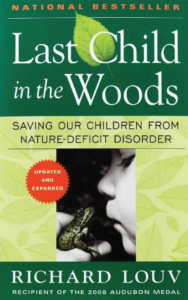
Growing up in rural America, my childhood was defined by long days outside and it forged a deep love of the natural world in me. Author Richard Louv identifies a very different modern world in his book, “The Last Child in the Woods”. He describes a world where screens dominate and the benefits of the natural world are often foreign to our younger generations. The result is a term he calls “Nature Deficit Disorder.” Back in my world, while I was thoroughly impressed that my kids had memorized all the lyrics from the Hamilton soundtrack, their fear of getting their hands dirty and the potential for a few bugs had already begun creating their own detached virtual world.
Being a landscape architect often comes with the expectation of having the most beautiful yard on the block. The reality is often quite different. Helping create someone else’s stream restoration, regional trail, local park or urban streetscape is certainly rewarding, but can take a toll on one’s own homestead. Like many others, even basic landscape maintenance is a major victory and getting help from your children is less pulling weeds and more often a feeling of pulling teeth. At the onset of our new virtual world I figured I could at least get a few personal landscape projects completed in between instruction time and work. If nothing else, I could get myself out of the house for a bit.
Starting in the backyard I began by removing debris piles, fixing a busted irrigation system, pulling weeds from long neglected beds, and actually mowing the lawn for once. Each session began with a gentle push to try to get some family participation and quickly devolved into complaining and my own personal moping on my parental shortcomings. Their disregard for everything outside the walls of our home and infatuation with their coveted daily one hour of screen time was maddening. Deep down I knew this wasn’t an isolated incident but was a pattern that was emerging over the years as we tried to juggle jobs, school, sports, and an endless array of perceived demands. Our initial online learning setup only put me more on edge.
Once finished with backyard basics I started on the pollinator “garden”. Garden being a loose term as I bought three milkweed plants and never quite got them out of their containers or planted in the ground. Then a funny thing happened, caterpillars started showing up. For those versed in basic biology, maybe not so funny and more basic science, but it was like the kids got a new puppy, or the equivalent of one hundred new puppies. Off the couch and round the clock checks on their numbers, food supply, chrysalis formation and eventual hatching were the centerpiece of the day. We couldn’t buy enough milkweed and eventually learned how to propagate our own. They even put their screens to good use and with the help of my wife created a home video. Motivating kids to get outside is easier when butterflies are involved and you’ve already done the weeding.
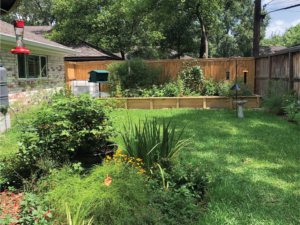 Based on the success of the first project, we moved onto birds. We purchased two “squirrel proof” feeders and filled them to top. To the kid’s great surprise…..nothing but squirrel calisthenics. Not having paid enough attention to the backyard, one day I peeked around the garage and noticed what appeared to be a scene from “The Birds” in my next door neighbor’s tree. Peering over the fence revealed a smorgasbord of an open feeder dripping with seed and an irresistible bird buffet. We just couldn’t compete. Guess the neighbor was smart enough to know there is no such thing as squirrel proof. Still, the occasional wren, chickadee, and cardinal would show up and less showy doves, blue jays, and even more squirrels frequented our feeders.
Based on the success of the first project, we moved onto birds. We purchased two “squirrel proof” feeders and filled them to top. To the kid’s great surprise…..nothing but squirrel calisthenics. Not having paid enough attention to the backyard, one day I peeked around the garage and noticed what appeared to be a scene from “The Birds” in my next door neighbor’s tree. Peering over the fence revealed a smorgasbord of an open feeder dripping with seed and an irresistible bird buffet. We just couldn’t compete. Guess the neighbor was smart enough to know there is no such thing as squirrel proof. Still, the occasional wren, chickadee, and cardinal would show up and less showy doves, blue jays, and even more squirrels frequented our feeders.
The next outside project became a centerpiece of the yard and another major milestone for us all. Time to grow our own food and build a raised garden. Using my design background an 8 foot by 25 foot bed was carefully planned and probably overdesigned. Now starting to get hotter, I was prepared for a day of solitude and got up early to beat the heat. Needing to remove sod and too stubborn to rent a sod cutter, hand digging would commence at sunrise.
Back inside the house, for several years now our son had outsmarted his parents. Recognizing he only had a maximum of one hour of screen time daily, he began to leverage our catatonic morning state and his own early bird tendencies. Waking up earlier meant he could extend his affinity for screens. The parental security team was often literally caught sleeping on the job. Afterwards, when confronted he would plead for an extension and bemoan his curse of early morning waking and lack of things to do.
Shortly after starting the raised garden, my son walked out and asked a question I never expected and will never forget. “Daddy, can I help?” What had happened to the kid who whose temperature and humidity demands could be used to finely calibrate any HVAC system? The same one I had set an alarm for to remind him screen time would be over at 7:30. No screens, no complaints, no hesitation, just digging? Did he actually get up early to help with the yard? Needless to say, I was a bit suspect at first but to my surprise he stuck it out the whole time and even helped pull weeds. Our initial small pollinator and bird experiments had instilled a sense of ownership and commitment to the natural world and excitement for what could come next.
After cutting, measuring, and assembling wood for the garden bed, wheel barrowing 5 yards of garden soil from 150 feet away, and planting a variety of vegetables and herbs both kids were exhausted but now all in. Or, at least mostly. Free mulch was acquired and spread over the garden for temperature, moisture, and nutrient control.
The mulch was obtained from adjacent neighbors who were raking their leaves up with the intent to put them on the curb for yard waste day. To save on watering costs and teach water conservation multiple 55 galloon rain barrels installed. Former olive containers were re-used and outfitted with simple plumbing parts obtained from the local hardware store.
The garden quickly filled in and produced summer tomatoes, spinach, arugula, peppers, purple peas, citrus, and blueberries. Additional rosemary, mint, lavender, and lemon grass also thrived. Kid labor and maintenance was also now a regular contribution and less of a fight. The garden became a topic of conversation with their friends and family and source of personal pride. Contributions to meals and gifts to friends and neighbors became normal.
With the recent change of seasons, butterflies and birds continue to frequent the yard and we keep our textbooks nearby to identify new migratory species. The addition of native shrubs to perimeter beds have provided more wildlife protection and increased our birding diversity. We even found a birding app and enjoy hearing their replies to our I-phone at sunset. Outdoor game nights, meals, movie nights, and tent camping have become favorite family activities in what has been affectionately termed our “Backyarden”. We are currently excited to plant our fall vegetables and are enjoying the hummingbird migration and their bickering at our feeders.
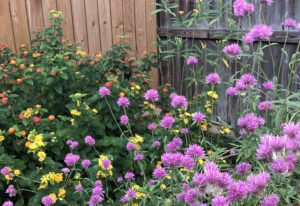
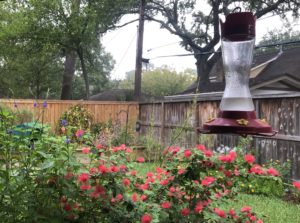
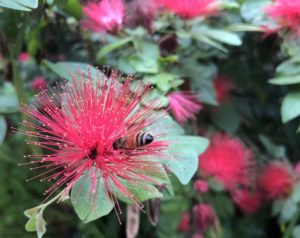
This outdoor learning environment can sound deceptively simple but hasn’t always come easy. Houston in the summer takes its toll on plants and humans alike. The heat and humidity has certainly claimed its share of victories. Project novelty and motivation also has its own unpredictable curve. Irregular weather, frequent watering, plant mortality, and pest infestations are challenges only overcome with patience and persistent. As all good science teachers know it’s about the questions asked, lessons learned and not pre-determined results or bending the answers to serve our own means. Good grades also take a bit of hard work but have been well worth the effort.
While relatively small, our space has succeeded in providing family bonding and immediate access to what France Ming Kuo refers to as “Vitamin G.” Regular exposure to green environments that promote positive physical, social, and physiological functioning. This resulting Green vitamin is an essential element for healthy living.
Easily taken for granted during the stresses of the modern world, its value has only been amplified during this school year.
In a world of screens, it is becoming increasing important that the picture window once again be a portal to the benefits of green space for our youth. While a visit to the local botanical garden or natural area is exciting and valuable, there is more “home”work to be done. The path of least resistance and maximum exposure should be a straight line to your own backyard conservancy. Decades of research has shown the benefits of nature whether they be in the form of improved critical thinking, anxiety relief, enhanced creativity, or improved attention span. It’s nice to think these benefits are all easily within reach.
From a broader ecological perspective, author Douglas Tallamy argues that a series of ecologically rich residential landscapes has great potential to address some of our greatest environmental issues and re-establish biodiversity. As society has become more urban, our personal domains are increasing becoming the center for potential change. In particular, he addresses the need to utilize native plants and their natural biological connectivity to local wildlife. Our recent science experience has been a showcase for this concept. From our outdoor couch we have been witness to an amazing transformation from sterile lawn to a thriving community of biodiversity with active space mixed in between. This approach is certainly scalar and can be applied from small patio to expansive yard and beyond.
While tucked away behind our 8′ wood privacy fence, I often imagine this concept applied across the neighborhood and the valuable matrix that could be created. As we watch the butterflies float through the day, I am often thankful for the benefits Vitamin G has brought to our family and its potential for others when taken regularly.
Starting with a few small milkweed plants, life quickly found its way back into our curriculum and we hope our outdoor classroom experience can bring life back to the doorsteps of others.
 About the Author
About the Author
Matt Baumgarten is the Associate Principal at SWA, an international landscape architecture, planning and urban design firm renowned for the creativity, responsiveness, and resilience of its work. He was a speaker for our Blues to Greens Forum.
